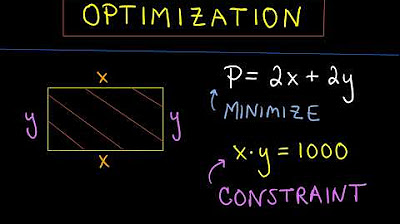Optimization Day 1
TLDRThis educational video script explores optimization problems in calculus with two practical examples. The first scenario involves a swimmer trying to reach a town in the shortest time by determining the optimal point to swim to shore. The second example focuses on minimizing material costs for a can by finding the dimensions that yield the least surface area for a given volume. The script guides viewers through setting up equations, taking derivatives, and using a calculator to solve for the optimal values, emphasizing the application of calculus in real-world problems.
Takeaways
- 🏊 The video discusses a calculus problem involving a swimmer who needs to reach a town in the shortest time possible by swimming and walking.
- 📏 The swimmer is 2 miles away from the shore and the town is 3 miles down the coast, making the swimmer's total distance a combination of swimming and walking.
- 🕒 The swimmer can swim at 2 miles per hour and walk at 4 miles per hour, and the goal is to minimize the total time to reach the town.
- 🔍 The problem is approached by setting up an equation for the time it takes to swim and walk, and then finding the derivative to minimize this time.
- 📐 The Pythagorean theorem is used to establish the relationship between the swimmer's swimming distance and the shoreline.
- 🧮 The time equation is derived from the distance formula (distance = rate × time), and is set up for both swimming and walking segments.
- 📉 To find the minimum time, the derivative of the time equation is taken and set to zero to find the critical point.
- 📈 The video demonstrates the use of a calculator to differentiate the time equation and solve for the variable x, which represents the distance to swim to the shore.
- 📦 The second part of the video addresses a problem of minimizing the surface area of a cylindrical can to reduce material costs, given a fixed volume.
- 🔢 The volume of the can is converted from ounces to cubic centimeters, and an equation for the surface area is formulated with one variable using substitution.
- 📈 Similar to the swimmer problem, the derivative of the surface area equation is taken and set to zero to find the dimensions that minimize the material used for the can.
Q & A
What is the main problem discussed in the video?
-The main problem discussed in the video is how to minimize the time it takes for a swimmer to reach a town from a point in the ocean, given certain distances and speeds for swimming and walking.
How far is the swimmer from the shore initially?
-The swimmer is initially two miles away from the shore.
How far is the town from the swimmer's entry point on the shore?
-The town is three miles down the coast from the swimmer's entry point on the shore.
What is the swimmer's swimming speed?
-The swimmer's swimming speed is two miles per hour.
What is the swimmer's walking speed?
-The swimmer's walking speed is four miles per hour.
What is the swimmer trying to minimize and why?
-The swimmer is trying to minimize the total time it takes to reach the town, as this would be the most efficient way to get there.
What mathematical concept is used to solve the swimmer's problem?
-The mathematical concept used to solve the swimmer's problem is calculus, specifically minimizing a function by finding its derivative and setting it equal to zero.
What is the purpose of using the Pythagorean theorem in this context?
-The Pythagorean theorem is used to calculate the hypotenuse of a right triangle, which represents the distance the swimmer swims in the ocean.
How does the video demonstrate the process of finding the minimum time?
-The video demonstrates the process by setting up a time equation based on the distances and speeds, taking the derivative of this equation, setting the derivative equal to zero, and solving for the variable x.
What is the second problem discussed in the video?
-The second problem discussed in the video is how to minimize the surface area of a can to use the least amount of metal, given a fixed volume.
How is the volume of the can related to the volume equation in the video?
-The volume of the can is given as 12 ounces, which is converted to 355 cubic centimeters. This volume is then used in the volume equation \( \pi r^2 h = 355 \) cubic centimeters.
What is the final step in solving the can problem?
-The final step in solving the can problem is to find the dimensions (radius and height) that minimize the surface area, which involves finding the derivative of the surface area equation, setting it equal to zero, and solving for the variable.
Outlines
🏊♂️ Optimizing Swimmer's Route to Town
This paragraph discusses a calculus problem involving a swimmer who is two miles out in the ocean and needs to reach a town three miles down the coast. The swimmer can swim at a rate of two miles per hour and walk at four miles per hour. The goal is to determine the optimal point along the shoreline where the swimmer should swim to minimize the total time to reach the town. The problem involves using the Pythagorean theorem to set up a right triangle and then deriving a time equation based on the swimmer's rates of swimming and walking. The solution involves finding the derivative of the time equation, setting it to zero, and solving for the variable x, which represents the distance the swimmer should swim along the shoreline.
🥫 Minimizing Material for a Can
The second paragraph tackles a problem of minimizing the amount of metal used to make a can, aiming to reduce costs. The problem starts with a volume of 12 ounces, which is converted to 355 cubic centimeters. The objective is to minimize the surface area of the can. The volume equation is set up using the formula for the volume of a cylinder (πr²h), and the surface area equation is derived accordingly. The challenge is to reduce the number of variables from two (radius and height) to one. A substitution is made to express the height in terms of the radius, leading to a single-variable equation for surface area. The derivative of this equation is taken, set to zero, and solved to find the optimal radius. The height is then calculated based on the optimal radius, providing the dimensions for the can that minimize material use.
📚 Applying Calculus to Real-World Problems
The final paragraph wraps up the discussion by highlighting the application of calculus in solving real-world problems. It emphasizes the process of minimizing or maximizing functions by finding their derivatives and setting them to zero. The example of finding the minimum surface area of a can is used to illustrate this process, showing how calculus can be used to optimize solutions in practical scenarios. The paragraph also includes a brief mention of the cost implications of material use in manufacturing, reinforcing the relevance of these mathematical concepts in everyday applications.
Mindmap
Keywords
💡Optimization
💡Fluff Question
💡Pythagorean Theorem
💡Hypotenuse
💡Rate
💡Derivative
💡Minimum
💡Surface Area
💡Volume
💡Differentiation
💡Cost Minimization
Highlights
Introduction to the concept of over-optimization in calculus.
Exploring a fluff question involving a swimmer trying to reach a town in the minimum time.
Using the Pythagorean theorem to label the hypotenuse in a right triangle.
Minimizing time by setting up a time equation involving swimming and walking.
Deriving the time equation and setting up the derivative to find the minimum time.
Verifying the minimum by checking the derivative crosses the x-axis from negative to positive.
Calculating the minimum time using a virtual TI calculator.
Discussing the practicality of using calculus in real-life scenarios like swimming.
Transitioning to a problem involving minimizing the cost of making a can by minimizing its surface area.
Converting volume from ounces to cubic centimeters for the can problem.
Using substitution to reduce the number of variables in the surface area equation.
Deriving the surface area equation and setting up the derivative to find the minimum surface area.
Graphing the derivative to verify the minimum surface area.
Solving for the dimensions of the can that minimize the surface area.
Calculating the radius and height of the can to minimize material costs.
Highlighting the importance of consistency in problem-solving approaches.
Transcripts
5.0 / 5 (0 votes)
Thanks for rating:





